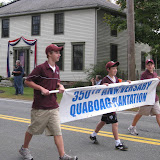I was so excited when my friend Anne invited me to join the AFE (Association for Facilities Engineers) Chapter 33 September meeting as a guest, because on the agenda was a 50-minute walking tour of Fenway Park. “How cool is that!” I thought to myself. In the late afternoon, the two of us traveled from Worcester to Boston, arriving in time to find parking near Northeastern and then walk from Huntington Avenue through the Fens to Yawkey Way and Gate E on Lansdowne Street. It was a beautiful sunny day, even a bit hot for this first day of fall.
Members and guests checked in around 5 pm; there was a cash bar and hors d’oeuvres set up near the concourse; then we sat down to listen to the Fenway Park facilities manager talk briefly about his work. Here’s some of what he told us: In 2002, new owners took over management of the ball club • 2012 will be the 100th anniversary of Fenway Park • At one point, there was talk of tearing down Fenway Park and rebuilding it due to numerous problems, but that didn’t happen • People complained about the sight lines, the bathrooms, the concessions • The solution settled upon was “small improvements” such as creating additional seating and improving use of space • For example, the Green Monster seats and upper level boxes were added in the past 8 years • The small wooden seats all date from either 1912 or 1934 and an extensive refurbishment project which includes the concrete foundations is ongoing • The ballpark is now more fully integrated into the neighborhood, which is undergoing a revival with new businesses welcomed • Fenway Park is now a 365-day a year facility and hosts activities in addition to baseball games • The intention has been to maintain the ballpark with under 40,000 seats and retain the comfortable atmosphere while providing amenities fans deserve.
Since there were about 100 of us, we split into two groups for the official tour with the Fenway Park tour guide, which began shortly after 6 pm. We traipsed through the stands, up through the press box, and then back to the concourse, stopping periodically to look around, listen to the guide, and take it all in. Before dispersing for the evening, the group enjoyed a light repast. Of course hot dogs were on the menu, but being a conscientious vegetarian, I refrained.
I scribbled madly as our guide talked, but less than half-way through, I gave up, as there was just too much fascinating information. Here is what I’ve been able to transcribe from my notes: First called the Red Sox in 1907, the team began its existence in 1901 as the Boston Americans (though their original name is hard to establish), and for the first decade or so, they played at a field nearer the current location of Northeastern University • The team was championship quality in the early years, winning pennants in 1912, 1915, 1916, and 1918 • In their first game at Fenway, on 20 April 1912, the Red Sox beat the New York Highlanders (forerunner to the Yankees) 7-6 in extra innings • Team quality began to decline in 1919, when the team lost 17 out of 20 players from the previous year • The park was built at its current location because the owner already had title to the land, which was originally landfill (the Fens has been a marshy area since Boston was first settled) • Five streets were already in place in this location, so the Park was built in the existing space, which explains its odd shape • The dimensions are these: 302 feet to the right field foul pole, 310 feet to the left field foul pole, and 420 feet to center • The present ball club and stadium are in some respects the creation of one man: Thomas Yawkey • 1933 marks the beginning of the team’s resurrection, which is the year Yawkey, a man with impeccable baseball connections, bought the club • Beginning in 1934, Mr Yawkey instituted a number of improvements, including building the wooden seats, adding bleachers, putting up the left field fence where there used to a hill on which people would picnic during ball games • The left field green wall was originally blue, but Mr Yawkey’s wife disliked the color so much that it was changed to green, now a copyrighted shade • The one red seat in Section 42, 502 feet from home plate, commemorates the location where a Ted Williams’ homer knocked some sense into a Yankees fan • The ladder near the Coca-Cola advertisement was once used after every game to collect foul balls but is no longer functional • The infield has a modern drainage system which shortens rain delays; the sod is grown in Rhode Island.
We’ve arrived at Fenway Park:

This sculpture of Ted Williams stands outside the gates:

We’re looking out toward right field:

The seats in this section have been refurbished; the tiers are clearly visible with the Budweiser sign in the near distance and the Boston skyline in the background:

We are looking down at the infield, the pitcher’s mound, and home plate.

This view of the field is from the press box, which was enlarged, enclosed in glass, and air-conditioned in 1975:

Visible at the left is the landmark Citgo sign; at the bottom of the photo is the scoreboard which is still manually operated:

These are numbers that have been retired; the blue #42 belonged to Jackie Robinson, honored for breaking the color barrier in major league baseball:

We’re looking across the field at the EMC Club seating and the State Street Pavilion as the sun sets:

If I’ve gotten any of my facts or captions wrong, please let me know and I’ll amend the post.
Go Red Sox!

